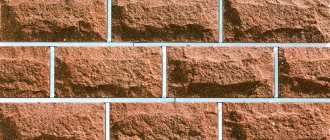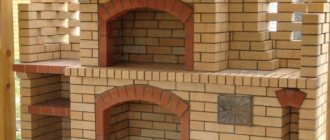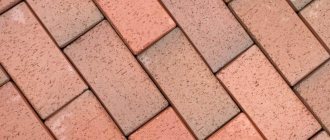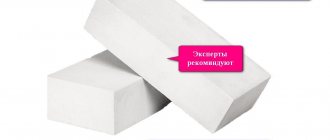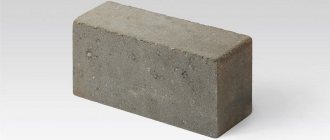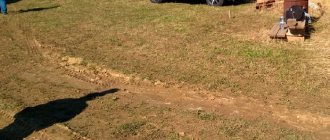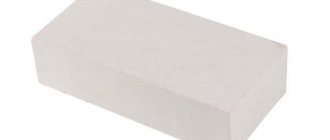Where to use broken bricks?
There are many uses for broken bricks.
The price of broken brick is less than the cost of crushed stone and gravel, so broken brick is widely used in construction, strengthening roads, landscaping and geoplastics (landscape work). In construction, broken bricks are used instead of expanded clay as a backfill for floor screeds, but the screed needs to be reinforced with metal mesh.
In concrete for the foundation, up to one-fourth of the filler can be used instead of gravel, broken bricks can be used. Such concrete will withstand a good load and there will be no cracks.
In marshy areas of roads, broken bricks are used to strengthen and prevent soil subsidence, as a material with good drainage properties.
When landscaping, making paths, use moisture-resistant bricks (silicate). Ceramic brick will crumble within 2-3 years and will require additional bedding from fine broken bricks or gravel.
Broken brick is very good for landscape work. When making slides, the shape is formed with a large block of red brick, using it as a substrate. Warm and porous brick absorbs and retains moisture well, which is what the roots need.
Recently, it has become fashionable to install gabions, various structures made of metal mesh filled with large and small stone fillers, used as supports, fences and fences. Broken bricks of different colors can be used as fillers.
After construction there are always pieces of broken brick left. Depending on the type of brick they are used
either for its intended purpose on the farm, or for landscaping and decorating the site along with other construction remains.
Household buildings - showers, toilets, sheds - are made from ordinary building bricks of grades higher than M 175. The remains of ceramic are used for the lower rows and foundation pillars, and silicate is used for the walls and partitions. The foundations of greenhouses, trenches for vineyards, and compost pits are laid out of ordinary wood. If the masonry is also treated with a waterproofing compound, it will last up to 100 years. Broken ceramic bricks are used to line the walls of toilet pits and garden stoves made of fireclay bricks, because Fireclay bricks are quickly destroyed by water and frost. Its remains are used indoors for partitions or decorative finishing. Sand-lime and ceramic bricks of grades M-50, M-100 can only be used for the top of fences or with crushed stone for filling holes on roads. They cannot be used to lay out paths. Long-lasting paths are made from clinker, facing, hyperpressed bricks or building bricks with a high index. You cannot use broken bricks when pouring the foundation of a house.
How to profitably use broken bricks?
Broken bricks, often formed during the dismantling of old buildings, can be used for various purposes. It is convenient to fill a pothole with it or use it to improve the area. There are many ways to make good use of broken bricks and benefit from them.
Most often, broken bricks occur after dismantling houses.
How do you get broken bricks?
Careful dismantling of brickwork helps preserve the structure of the material, which can be used for new buildings. This type of brick is more often used due to its low cost, constant availability and great possibilities for its implementation.
Previously used brick can be safely used for filling paths or other purposes . In this case, it must be crushed using special mechanisms that transform the brick fragments into small crumbs or into a mixture of different-sized pieces.
Depending on the size of the resulting fractions, the scope of application of such raw materials is determined.
For construction purposes, 2 main types are used:
Broken bricks are used to fill holes and pits.
- Broken brick is formed during the dismantling of old buildings by breaking the building walls with a hydraulic hammer. In this case, large fractions are obtained, consisting of several bricks, fixed with hardened concrete mortar. Such building material is inexpensive, and if it is processed in crushers, it can be sold at a higher price.
- Broken brick or scrap, which is obtained at the factory, is also often used for construction purposes. Due to the fact that it has not yet been used, it costs more than broken material. Some builders use this kind of defect for laying utility rooms, but you need to first reconsider such bricks, choosing the most suitable one from the whole mass. It is advisable to purchase chips without intermediaries from the manufacturer.
Often the line between broken brick and broken brick is blurred, and suppliers call both varieties the same. In this regard, before purchasing recycled building materials, it is necessary to clarify what type is offered for sale and what are the dimensions of the chipped bricks. They can offer monolithic blocks consisting of several bricks, or small stones up to 2 cm in size.
Using crushers you can create pieces ranging in size from 1 to 70 mm. If you crush the walls with a hydraulic hammer, you can get brick fractions from half to a whole piece (40-100 mm). You can also grind the fight at home using a sledgehammer and a hammer. The size of the fractions is selected taking into account further use.
Scope of application of broken bricks
The fairly low cost of the material determines the profitability of using brickbats. It is used for various purposes:
Broken bricks can be used to create gabions.
- Backfilling pits and trenches is appropriate if for some reason there is no primary soil left. It is worth filling deep pits with uncleaned scrap; monolithic pieces of concrete can be placed at the bottom.
- Of all types of brick, silicate is considered the most durable.
It can be safely used to level roads. Unlike red bricks, which can quickly collapse under the influence of moisture, white bricks retain their characteristics and shape for a long time. That is why they are used to fill roads. The silicate waste will roll away within one season and form a smooth surface.In contrast, crushed stone and gravel compact the road surface within a few years. It is better to level out holes and potholes on the road using small pieces of raw material.
- Compacting holes while installing support posts is another way to use broken bricks.
After installing the support and leveling it, it is backfilled with sand and broken bricks. The backfill should be carefully compacted so as not to displace the post. - Boil has excellent drainage properties, making it ideal for draining wetlands.
- Most often, broken bricks are used to create secondary highways.
A broken brick road is created when it is difficult for equipment to reach a construction site. - Any type of combat adheres perfectly to concrete pouring. However, before adding to the solution, large fractions must be crushed to an average size of 2-4 mm.
- Gabions are a new decorative option in landscape design.
Durable and long-lasting fencing is created from rectangular mesh of various sizes, filled with stones and broken bricks.
Landscaping using broken bricks
You can use the chip to decorate the area. You can use it to lay out paths, decorate flower beds, and fill in holes where water collects after rain.
To form flower beds and paths in the garden plot, clean screenings (0-10 mm) are used. It is better to make paths from sand-lime bricks, which are resistant to moisture.
The use of ceramic material for this purpose requires further addition after several years.
A small layer of small fragments of red and white brick can be used to decorate the concrete blind area near the house.
It is also necessary to take into account the type of source material in order to correctly determine the scope of application. Broken sand-lime brick can only be used for backfilling, because it lost most of its properties during the period of its main use. It is recommended to use crushed fireclay material as a filler for the production of fire-resistant mixtures.
When purchasing broken products, you should understand that sellers indicate the cost of 1 m³ of material. When purchasing the required volume, the customer must take into account that delivery will double the cost of the brick.
Sometimes companies set a minimum volume of material sold with delivery, in some cases this is even more profitable. Before purchasing, you need to calculate the required volume.
It is worth considering that sometimes it is better to give preference to a more expensive brick, but save on transportation, than to buy a cheaper analogue, but at the same time pay more for transportation.
Source: https://KubKirpich.ru/zabor/boj-kirpicha.html
TOP 10 ideas for using old bricks on the site
- TOP 10 options for using bricks in the country
Every construction or renovation necessarily ends with the presence of leftover building materials. Much will definitely become useful in everyday life, but we cannot exclude the fact that everything unnecessary will sooner or later become a source of clutter in the area. Brick is a building material that can serve anyone faithfully, even if the material is not entirely new - this does not affect its functioning in any way. With the help of brick, you can arrange a lot and create real comfort zones on the site, which is why we offer an expanded selection of options for using brick on the site with the maximum practical purpose.
TOP 10 options for using bricks in the country
- Sidewalk or garden paths. The simplest versions of placing a whole brick on a site manifest themselves in the form of creating a path. Brick is a durable material that can be a good alternative to paving slabs. You can combine colors and shades, create drawings, edges, and try to create combinations. If the brick has a distorted shape or is simply the result of “dismantling” an old building, do not rush to throw it away, as it can be usefully used in the country to create paths. Grind the brick as much as possible using any available method, create brick crumbs. The crumbs will become a simple and excellent material for paths. Install a whole brick along the perimeter, and generously fill the inner path with broken bricks. For the comfortable functioning of such a path, be sure to replenish the amount of crushed bricks, then such a path will become indispensable throughout the dacha.
- Ancillary buildings on the site. If there are enough bricks, you can take the plunge for construction. You can try to create an outdoor shower, a utility room, a primitive tool shed or even a chicken coop with your own hands. The main thing in this matter is not the beauty of the final result, but its practicality. If, as a result, such a structure can be used, you have coped with the task. Don't worry if everything didn't turn out perfectly. Nowadays, there are many options for making attractive cladding - various cladding and decorative plasters will help, if necessary, transform any construction, thereby hiding the fact that the brick is old.
- Curbs and territory boundaries. If you mainly have not whole “slabs” of bricks, but their halves, try creating borders from them. Using bricks for borders is a practical application, since such a solution will not only be very convenient to use, but also a beautiful element. The combination of red and white bricks in a certain “step” looks great.
- Floor in any building. Brick is the most reliable, time-tested building material. It is brick that can be safely laid on the floor in temporary sheds, summer kitchens, sheds and garages, any outbuildings and basements. This use of brick is quite troublesome, but if everything is done according to the rules, then success will be guaranteed.
- Brick is a reliable foundation. One option to create a strong foundation is to use old brick. This option will be no less strong than a new one, but since this is a foundation that is hidden from view, you can safely use leftovers or one that has already been used before - it doesn’t matter. You should not look at the external data of the brick; the strength grade is more important.
- Broken brick is an excellent strengthener. When building any structures, or to provide strength, broken bricks should be used. This material is quite strong and will become indispensable if it is necessary to significantly strengthen the building. Columns for stone fences can be safely strengthened with mortar, which is poured into a hole where broken bricks should first be placed. This “explosive mixture” will become a very high-quality strengthener and will help the posts last a long time.
- Material for laying drainage pits and treatment facilities. When there is no sewer system on the site, then drainage pits are the only option for comfortable living. To competently create such a structure, you should use old brick, which will serve as the main material for masonry. To begin with, a hole of the required shape and depth is dug, then it is lined with bricks on all sides, but not completely, but in a checkerboard pattern, leaving a space of one brick. Such masonry will not only strengthen the pits from destruction, but also a good drainage system.
- Creating a flower bed. A good option is to create the boundaries of a flower bed using bricks. Use your imagination, because there are a lot of variations for creating a truly beautiful flower bed using unnecessary bricks. Full or half masonry, at an angle or cut, experiment with combinations of red and white bricks, in one row, or create an openwork high barrier - whatever your heart desires.
- Barbecue area, fire pit, old brick oven. There is always a place on the site where barbecue and various grilled dishes are prepared during the festive feast. It is this kind of area that can be completely equipped with brick - a barbecue, a stove, a place to store firewood, a fire pit. It is not only convenient, beautiful and practical, but also durable.
What can be made from old bricks
Ways to use old brick:
- Construction of a bathhouse, barn, toilet, summer shower, cellar.
- Brick paths at the dacha.
- Garden paths covered with small brick chips.
- Brick fence.
- Borders for flower beds, beds, sidewalks and paths.
- Brick floors.
- Blind area around buildings.
- Brick foundation for the construction of a barn.
- Strengthening pillars, priming.
- Arrangement of drainage for a septic tank.
- Line the walls of the cesspool.
- Decorative buildings, such as a fountain, garden furniture, and so on.
- A well for making a fire, a grill, a barbecue and so on.
Brick outbuildings
If the quality of the old brick is quite tolerable, then you can easily use it in the construction of utility rooms.
At the dacha or in the garden there is always a place to use old bricks, be it a chicken coop, a basement or an outdoor shower.
As a rule, such buildings are not pretentious to aesthetics. Their main purpose is completely different. As a last resort, any building can be plastered.
An important condition is to protect the brick from moisture. This can be done by using a water repellent, or by hiding the walls under finishing materials.
Since used bricks begin to crumble very quickly under the influence of moisture and low temperatures.
Paths made of old bricks in the country
There is a detailed article on the blog about how to lay out paths from old bricks in a dacha with your own hands. If you are interested in this option for using bricks, be sure to read the article.
Garden paths
If you have not just an old brick, but a broken brick, then you can fill the garden paths with it. Large pieces of brick should be further crushed in any convenient way.
You will not have to repair such a path. It is enough to occasionally sprinkle it with brick chips.
Or you can even fill up entire areas. Brick chips will not allow weeds to sprout, but will not harm trees or shrubs in any way.
How to use old bricks - borders
Old bricks, not only whole ones, but also halves, can be used as decorative borders. Moreover, it is not difficult to replace a crumbled element of such a border.
Brick partitions will decorate your site and bring some freshness to the surroundings.
Brick floors
There is an article on the blog that describes in detail how to lay brick floors. We advise you to familiarize yourself with the options for using old bricks for flooring.
And here we are simply stating the fact that even old brick makes wonderful floors. Provided the correct installation technology is followed.
If you don’t risk laying brick floors in your house, then try this option in any utility room.
And having done a test installation, you will be able to evaluate all the pros and cons of brick floors. Then you can make informed decisions about laying brick floors in a house or apartment.
Blind area around buildings
You can lay out not only paths in the garden or floors in the house from old bricks. A beautiful design option for blind areas would be to line them with bricks.
Moreover, there is now a tendency to decorate plots in an antique style. In this case, old brick is a cheap and beautiful decorative material.
Brick foundation for building a barn
A brick foundation is not a new idea. Brick has long been used for laying foundations, not only for barns, but also for residential buildings.
It should be noted that for the foundation it is best to use old bricks with a high strength grade.
Strengthening pillars, priming
Broken bricks are quite suitable for strengthening pillars. For example, when installing a horizontal bar or swing. You can also attach fence posts and so on.
The space between the pillar and the soil is filled with twisted bricks and filled with concrete. You will experience great savings in the consumption of mortar for pouring pole supports.
Also, broken brick is suitable as a primer when carrying out various works.
Septic tank
When arranging treatment facilities and drainage pits, old brick can be used as drainage.
In addition, whole bricks are used to strengthen the walls of drainage pits.
Decorative use
Using old brick for decorative purposes on your site is modern and fashionable.
The application options are endless:
- Fountains;
- Stoves;
- Sculptures;
- Flowerbeds;
- Fire pits;
- Arches;
- Benches, tables, chairs;
- Bridges.
And much more. Look at the photo on how you can use old bricks in your dacha and garden.
It all depends on your imagination and skills. You can experiment and not be afraid to express yourself in something new.
Fortunately, the building material is junk and in large quantities. Don’t be afraid to get to work, and you won’t notice how this activity will become a hobby.
And then you’ll start taking orders from your neighbors. After all, design is creativity. And the creative process cannot be boring. Decorate your yard, plot, and you will decorate your life.
Today we told you how you can use old brick. However, perhaps we missed something. Therefore, if you have more ideas for using old bricks, then share them in the comments.
Or you can attach a photo of your work. Good luck!
How you can use old brick, video review of the site in the yard:
A selection of ideas on how to use old bricks in your country house
Let's say you have some unused brick left at your dacha from construction, or from some alterations. This article will talk about what can be made from both whole and broken bricks. First you need to collect all the remaining building materials for storage in some dry room or under a canopy. Before you decide what you will do, you need to carefully inspect the brick for damage and chips, since it is not suitable for every building. If you have a large amount of whole bricks in stock, then you can safely begin construction.
Brick grill
Perhaps the most popular brick construction is the construction of a barbecue. This structure performs a pleasant rather than useful function. Many people make a barbecue out of metal; this is a more familiar design for ordinary people, but if you have the desire and building materials, then it is quite possible to make a barbecue out of brick.
The simplest design is to lay out a square of brick in the place where you are usually used to grilling kebabs. You can simply lay the bricks in several rows, without tying them together with mortar. The result is a collapsible structure, which, if necessary, can be removed to make room for some other building. Using the same principle, you can create a tandoor or barbecue at your dacha.
For more capital and permanent construction, you will first need to make a solid foundation and reinforce the walls with a metal mesh using a special fire-resistant mortar.
Brick oven
To make a brick stove, you need to have special knowledge, and this process will take much longer than making a barbecue. But if you are a purposeful person, then this difficulty will not be an obstacle. A stove in a dacha can be useful for building a bathhouse and for arranging an enclosed gazebo. You can design a regular summer stove or a special one to burn garbage.
Manufacturing of original benches
To create additional comfort and coziness on the site, you can make original brick benches. To install them, you will need to make a concrete foundation or well-compacted soil. The pillars for the benches are made of brick and cement mortar, 5 bricks wide. It is advisable to strengthen the corners with the help of a metal corner, which also sits on the mortar.
The masonry must dry for some time, then seats are installed on top of it, which can be made from any suitable material. Brick benches can have different shapes: square, corner or semicircular.
Construction of a toilet
If you have a sufficient amount of building material left, then you can think about a more serious construction. For example, an outbuilding, a shed or a toilet. Any structure made from brick will be a priori much stronger than from any other material, since brick is less susceptible to atmospheric agents. Building a toilet at the end of the summer cottage would be advisable even in that case. if you have all the amenities in your home. It's a good idea to always have a backup option. Such construction does not require much knowledge. The only thing you need to pay attention to is the strictly vertical position of the walls and at the initial stage of construction, provide for the installation of a ventilation vent.
Making a brick fireplace
If after all the construction you still have brick left, then you can build a simplified version of the stove - a fireplace. This is a more aesthetically pleasing construction than a conventional stove, and it will take much less time to make a fireplace. Burning wood in the fireplace will please the eye in inclement weather, when there is simply no way to do other work at the dacha.
Fireplace made of brick
By and large, this is the same fireplace, only installed in the yard. The simplest option for arranging a fire pit is to lay bricks in a circle. Before starting construction, you need to provide a solid base of tiles or concrete and, after finishing, secure the bricks with circles of wire or sheet metal. There are a great variety of fire pit designs, the only condition is that it must be located in such a place that the fire does not damage trees, bushes or buildings.
Brick fence posts
From the remaining bricks you can build fence posts that will frame the perimeter of the dacha. Columns of 4 bricks are quite suitable for installing a chain-link mesh, a wooden picket fence or a metal profile between them. Depending on the main material of the fence, it is necessary to provide specific attachment points.
Broken brick cellar
Broken brick is quite suitable for building or lining both underground and above-ground cellars. Also, the remains of broken bricks can be used to pave the inside of the cesspool and cover the bottom with broken bricks. In this case, the water will go underground faster.
Brick garden path
To make a brick path at your dacha, red, yellow or silicate bricks, both broken and whole, are suitable. First you need to dig a small trench, lay out the base of sand, and then lay brick on top. After laying out the path, you need to thoroughly water it and compact the brick. The advantage of such construction is the availability of the material, its low cost and ease of construction of the path.
Making borders for flower beds
A brick of any color, either whole or in pieces, is suitable for framing a flower bed. Since the material is small in size, it can be used to build a border of any shape. Brick can also be used to frame paths or free-standing trees and bushes.
Brick rock garden
To create an alpine slide, the most ideal material would be broken brick. It can be combined with any other material, stone, gravel, pebbles, boulders and so on. By the way, you can make good drainage from broken bricks when arranging an alpine slide.
We considered only a few options for using bricks in a summer cottage. You can make anything you want from this material. It all depends on your imagination.
Receiving material
In the process of careful dismantling of brickwork, the original structure of the material can be preserved, which allows it to be used in the future. This type of brick is always available, it costs little and can be used in different cases. Used bricks can often be seen on roads. Before such use, the material is crushed, for which appropriate equipment is used. Depending on the needs, the brick can be crushed into pieces of different sizes or even crumbs. The choice of the area of use of the material directly depends on the size of the fraction.
To implement construction tasks, in most cases, two types of such material are used:
- Broken brick. It is obtained during the dismantling of old buildings, breaking their walls with a hydraulic hammer. Ultimately, large elements are formed, which include several bricks mixed with cement mortar. This building material has a minimal cost, but after grinding it, you can get more benefits.
- Brick broken or defective from the factory. Since the material has not yet been used, its cost is higher compared to broken brick. Individual craftsmen choose a suitable scrap and use it during the laying of various utility and utility rooms. The ideal option for purchasing defective goods is directly from the manufacturer.
Many suppliers do not differentiate between broken bricks and defective bricks. For this reason, it is necessary to find out in advance what exactly a particular seller offers and what the size of the material fraction is. Some suppliers sell stones with a diameter of up to 20 mm, while others sell large blocks, which include several bricks at once.
Crushing equipment allows you to crush waste or scrap into elements measuring 1-70 mm. Using a hydraulic hammer during demolition of buildings allows you to obtain pieces ranging in size from 40 to 100 mm. To crush bricks without the help of specialized equipment, you can use a hammer and sledgehammer. The size of the elements is selected depending on current needs.
How to use old brick?
It has become fashionable to use broken or solid old bricks in decorating cellars, gardens, home decoration or interior framing. This is an additional saving, this solution adds charm and creates comfort. Using this material, benches and barbecues are built, paths and platforms are laid out, and the walls of rooms are decorated. In this way, you can cover areas where it was previously difficult to walk due to rain. It is not necessary to have special skills, it is important to just turn on your imagination and start building.
What can you do with your own hands and how?
Options for using leftover old bricks:
- flower beds;
- curbs;
- paths;
- original benches;
- barbecues;
- cellar walls;
- fireplaces;
- gazebo tables.
Ideas on where exactly the use of red brick is appropriate can be found on many specialized resources: magazines and websites on construction, forums, and author’s programs.
This material is used as decoration for walls, reconstructing them to look antique, and for decorating garden furniture in the country. You can also use it to build crafts for the garden. The implementation of these decorative ideas is carried out with your own hands or with the help of construction teams who do professional masonry and know many options where it is important to use used bricks. It is also applicable in building decoration.
Where to use broken bricks - concrete, roads and gabions - Blog Stroyremontiruy
Broken bricks should not be thrown into a landfill if you live outside the city and continue construction, repairs or landscaping. Broken bricks can be used for a number of jobs and below we will tell you how and where this can be done. By using combat, you can save a lot of money, so don't miss the opportunity to keep your wallet tight.
Application of brick fighting
Broken bricks can be used in the following works:
- — Preparation of concrete,
- — Backfill under the screed,
- — Improvement of paths,
- — Filling gabions,
- — Road alignment,
- — Landscaping of the territory.
Let us immediately note that you can use broken red and white bricks, while white broken brick is more durable, it is not so afraid of moisture and does not crumble into construction dust under its influence.
Bedding and concrete
The broken brick perfectly replaces gravel in the production of concrete ; the proportion of broken brick in the solution can be from 5% to ¼. Such concrete can withstand loads well, does not crack or delaminate under the influence of temperature and humidity changes.
You can also replace broken bricks with expanded clay when adding under the screed. In this case, you won’t have to order additional material and you can save money. When using scrap for backfill, it is important to reinforce the screed with a metal mesh, which is laid on top of the bedding, under the screed. Mesh cell size from 20/20 mm.
Paths and roads
With the help of combat, you can level the road near your house. To do this, broken white or red bricks are poured into road potholes and compacted using a manual tamper. Such “patches” will preserve the health of the car, and you won’t have to remember “fools and roads” when leaving the cottage.
You can use it to strengthen and decorate paths on the territory of a country house. To do this, the path is first trimmed, 3-7 cm of debris is poured on top of the soil and it is compacted. If you have broken brick of two colors, you can mix it and sprinkle the path with this combined material - it’s beautiful and practical, because walking in the autumn slush on a hard path without puddles is more pleasant than on a swampy path.
Broken brick perfectly allows moisture to pass through, and after compaction it becomes an almost monolithic hard layer.
Gabions
Broken bricks can be used to fill gabions , that is, structures of different shapes that are made of metal mesh with cells of different diameters. In suburban areas, gabions are used to create enclosing structures near swimming pools, flower beds and even fences.
Broken bricks are poured into a gabion with a fine mesh until the structure is completely filled. Before backfilling, you can sift the waste, after which large pieces are sent to the gabion; the fines are used in concrete work and for decorating paths.
Landscaping works
If there are a lot of uneven areas in your suburban area, then they can be leveled with broken bricks. In this case, there will be no subsidence of the soil at the work site, the area will become smooth, like an alpine lawn. It is important to add brick in such a way that there is still room to put fertile soil on top - nothing will grow on baked clay.
How to use old bricks in your country house for design
There is an old brick in every dacha. How to use it to your advantage. Before throwing away the old brick, look at the photos in our article, maybe you like something.
This simple brick bench in the garden at the dacha will decorate your landscape. Making a bench is very simple. The brick is laid with dry masonry, i.e. without cement mortar, in a checkerboard pattern. They simply placed a thick wooden board on top. You can use an old concrete window sill.
In this photo, old red brick is used to decorate the tree trunk. Kiprich creates a border between the lawn and the soil near the tree. The circle is decorated with bright mulch.
Creating a circular patio from old red bricks also turns out to be quite simple. We deepen the circle for the future brick patio and select 20 cm of soil. It is better to lay the bottom with black material to prevent the growth of weeds. Then a layer of gravel, a layer of sand. We simply lay the cyprich on top in a circle. By making such a patio, you will save yourself from removing old bricks from the site and get a wonderful decoration for your garden.
Decor made from old bricks can be used both in the garden and in the apartment.
A brick path laid among gravel will help create a Japanese-style garden.
Did you like the article? Subscribe to the channel to stay up to date with the most interesting materials
How to lay out a garden path from broken bricks?
With proper use of the material and adherence to laying technology, a path made of broken bricks can serve not only as a functional element of the dacha exterior. A neatly paved path made from waste products allows you to effectively emphasize the style of the garden complex and improve the visual perception of the space.
Advantages and disadvantages of using broken bricks
The key advantages of using waste construction resources are:
- ease of installation. Paving garden sidewalks and paths from brick fragments requires only basic knowledge of working with the material and a simple set of tools;
- product availability. A waste resource allows you to save a considerable amount on the preparation of materials;
- the possibility of recycling construction waste with significant benefits for the budget. That is, there is no need to remove broken remains of products to clean the area.
Among the disadvantages of using leftover building materials, the need for additional processing to extend service life is noted. Moreover, this does not apply to clinker bricks, which have high performance characteristics.
Broken brick is an excellent material for arranging garden paths
How to use broken bricks
When planning how to use broken bricks in the country, home craftsmen find interesting solutions, such as:
- paving beautiful garden sidewalks;
- creating borders;
- design of flower beds and raised beds.
Also, when deciding how to use broken bricks, it is recommended to use recycled material in the construction of gabions and arranging the foundations for alpine slides. Most gardeners are keen on designing high vegetable beds, the design of which provides for the formation of a powerful drainage layer, where different-sized fragments of crops can also be effectively used. Using waste products, it is easy to build high-quality drainage when planting trees and shrubs.
As experienced tilers note, the use of unsightly material can yield quite original results. For example, from a product unsuitable for construction, you can make a path border by placing the specimens on the edge at an angle of 45°. To get a unique masterpiece in the form of a garden path with an original masonry pattern, you can organize a composition of broken bricks and whole bricks.
How to make a path from broken bricks: stages of work
In order for the end result to please you with decent decorative and functional characteristics, you should adhere to the technology of paving garden paths.
The path is marked using construction cord and wooden pegs.
Planning
When planning a brick path with your own hands, consider the following points:
- the width of the path is chosen so that two people can walk along it freely;
- the distance between the object being designed and the trees is at least 2 meters, otherwise the growing roots of the plantings may eventually lead to the destruction of the base of the structure.
If you are planning a sidewalk with turns, it is recommended to make them smooth for ease of use.
The top layer of soil is removed along the marking line
Tools and materials
When building a garden path, you will need the following tools and accessories:
- tape measure, pegs and cord for marking;
- shovel - bayonet and shovel;
- tamping tool;
- hammer - rubber and regular;
- usually trowel, brush;
- container for preparing the solution.
To process uneven edges of broken products, you will need a grinder with a diamond blade.
The entire surface of the trench is lined with geotextiles
In addition to the main building materials, you should take care of the availability of:
- sand and crushed stone of the middle fraction;
- Portland cement grade 400;
- geotextiles.
It is also worth having a garden wheelbarrow on hand for moving materials, and a hose for final surface treatment with water.
The sand is thoroughly compacted
Preparing the base
When deciding how to make a road from broken bricks when organizing a country landscape, perform the following algorithm for preparing the foundation:
- along the marking line it is necessary to remove the top soil to a depth of 20-25 cm;
- the trench is sprinkled with a leveling layer of sand 2-3 cm thick and compacted;
- the entire surface of the trench is covered with geotextiles;
- the non-woven fabric is covered with a layer of sand 2-3 cm thick;
- the next one is a drainage layer of crushed stone 10 cm thick;
- Then the drainage is covered with sand and a second layer of geotextile is laid.
Forming a border
The perimeter of the trench is decorated with a border. Here you can use a concrete solution or plastic products. It is also important to use a brick border, laying it on the edge. The curb structure is fastened in different ways: using cement mortar, steel reinforcing elements or other convenient means. After the border is formed, a dry cement-sand mixture is poured onto the geotextile and the composition is leveled using a rule taking into account water drainage from the surface.
The edges of the path are decorated with a solid brick border
Brick laying
When paving a garden path, one of the simple masonry options is used, including:
- classic spoon dressing in the form of a longitudinal pattern;
- herringbone pattern at different angles;
- “braid” single or double;
- alternating horizontal lines with vertical ones.
Broken bricks according to the selected pattern are laid on a prepared cement-sand surface:
- when laying, stones are tapped with a rubber hammer for better fit;
- sagging specimens need to be lifted by adding sand under them;
- after laying the material, pour a little cement-sand mixture onto the surface;
- Then, using a brush, sweep the compound to fill the seams.
At the end of the installation work, the surface is spilled with water to compact and set the seams.
Final processing
The last installation steps, including filling the joints with a cement-sand composition and water procedures, must be repeated after 2-3 days, when the cement has set well.
Practical tips for long-term use of broken brick garden paths:
- so that the surface of the sidewalk does not deform under the influence of moisture and temperature changes, the stones are treated with a water repellent or moisture-proof varnish;
- if clay brick is used, before installation the material is treated 2 times with a hydrophobic composition by completely immersing the product in liquid and drying it;
- The validity period of hydrophobic agents is 5 years; after this period of time, re-treatment of the pavement surface is necessary. The service life of an object is also affected by the level of intensity of operation.
The potential of broken brick, especially if the material is used in different colors, allows you to create interesting compositions, which is confirmed in the works of masters.
Original paths and unusual benches
You can cover the area around the building with bricks. Suitable for this:
- whole;
- broken;
- brick chips.
The material will look especially beautiful in combination with gravel. It is also combined with other materials, which may include tiles or crushed stone.
Using a cord, small crushed stone and sand, you can lay out the covering for the paths yourself. They will not only become decor at the dacha, but will also help create more comfortable conditions.
First you need to make marks with stakes, pull a cord or twine over them, then remove the top layer of soil about 20 cm, cover the base with crushed stone and sand. It is necessary to arrange a drainage layer near the path, and stones are laid on top of the sand.
READ ALSO: Proven methods for ridding your garden of slugs
Products in the form of brick benches will help create coziness and comfort in your personal plot. They are installed on a concrete base or on pre-compacted soil. Using the material and cement mortar, bench legs 5 stones wide are erected.
The joints need to be reinforced with metal corners, which are placed on the mortar. After the installation has dried, boards for sitting are placed on top. Using this material it is possible to arrange semicircular benches without allowing large gaps between the bricks.
